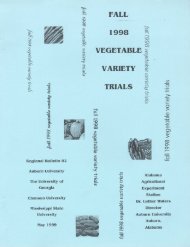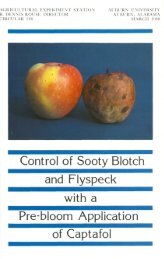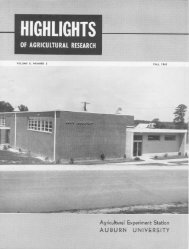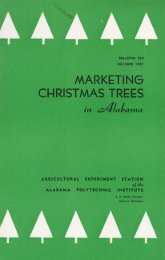1997 Ornamentals Research Report - AUrora - Auburn University
1997 Ornamentals Research Report - AUrora - Auburn University
1997 Ornamentals Research Report - AUrora - Auburn University
You also want an ePaper? Increase the reach of your titles
YUMPU automatically turns print PDFs into web optimized ePapers that Google loves.
30<br />
30<br />
ALABAMA AGRICULTURAL ExPERIMENT STATION<br />
ALABAMA AGRICULTURAL EXPERIMENT STATION<br />
WG, and Pendulum 60 WDG, when compared to that of lodged plants were short, stubby, and enlarged at the distal<br />
control plants.<br />
ends. Lack of development of these roots which normally<br />
Foliar dry weights of plants treated with Surflan provide support for developing shoots probably contributed to<br />
4AS, Rout 3G and Factor 65 WG were less than those of lodging. Pendulum 60 WDG-treated pampas grass generally<br />
plants in all other treatments. Plant mortality was 100% and had less root development than plants treated with the granular<br />
12.5% in Surflan 4AS and Rout 3G treatments, respectively formulations of pendimethalin, Ornamental Weed Grass<br />
(Table 2). Lodging occurred in 100%, 50%, and 12.5% of Control and Pendulum 2G; 50% of the WDG- treated plants<br />
plants treated with Factor 65 WG, Pendulum 60 WDG, and had lodged compared to 6.3% of plants treated with the<br />
Ornamental Weed Grass Control, respectively, at 75 DAT<br />
(Table 2). The authors observed that aerial support roots of<br />
granular pendimethalins.<br />
JI I V<br />
Chemical Control of<br />
Cercospora Leaf Spot of<br />
Crapemyrtle<br />
AUSTIN K. HAGAN AND J. RANDALL AKRIDGE<br />
Cercospora leaf spot, which is caused by the fungus,<br />
Cercospora lythracearum, is a common but often unrecognized<br />
disease of crapemyrtle in field nurseries and landscapes.<br />
Typically, spotting starts on the leaves near the base of the<br />
plant in July or August. The most noticeable symptoms of<br />
Cercospora leaf spot are yellowing and premature loss of<br />
damaged leaves. Although Cercospora leaf spot usually has<br />
little impact on the health of crapemyrtle, the spectacular fall<br />
color of some cultivars may be ruined by the progressive<br />
yellowing of the leaves and defoliation. In an AAES field trial<br />
in southwest Alabama, the experimental fungicide ICIA5504<br />
gave effective control of Cercospora leaf spot on crapemyrtle.<br />
METHODS<br />
In March 1996, bare-root crapemyrtle 'Carolina<br />
Beauty' were planted in a Benndale fine sandy loam at<br />
the Brewton Experiment Field on eight foot centers with<br />
10 feet between rows. Before planting, soil fertility and<br />
pH were adjusted according to the results of a soil<br />
fertility assay. On March 20 and July 3, half pounds of Trea<br />
16-4-8 and 12-6-6 fertilizers were uniformly distributed<br />
around each tree. A trickle irrigation system was Ban<br />
ratings of leaf spot incidence and defoliation were made on<br />
Oct. 10. The rating scales used to access disease is listed at the<br />
bottom of Table 1.<br />
RESULTS<br />
Light to moderate leaf spotting was seen on all the<br />
fungicide-treated crapemyrtle, as well as the unsprayed<br />
control. Leaf spot levels were considerably lower on the<br />
crapemyrtle treated at two-week intervals with all three rates<br />
of the experimental fungicide ICIA5504 or every week with<br />
Banner 1.24 MEC, as compared with the unsprayed control.<br />
On the ICIA5504-treated crape myrtle, spotting and yellowing<br />
of the leaves was confined to the lower 5-10% of the tree<br />
canopy. Typical leaf spot symptoms were seen on 25% or<br />
more of the leaves of crapemyrtle treated at two- to four-week<br />
intervals with Banner 1.24 MEC and the unsprayed control.<br />
Defoliation ratings generally mirrored those for leaf spot. The<br />
least disease-related defoliation was noted on the crapemyrtle<br />
sprayed with ICIA5504. No differences in defoliation were<br />
seen across rates of this fungicide. Defoliation was not<br />
reduced by any treatment of Banner 1.24 MEC as compared<br />
with the unsprayed control.<br />
Table I. Chemical Control of Cercospora<br />
Leaf Spot on Crapemyrtle<br />
Rat per icDisease rating'<br />
tment Rate per Spray interval Disease ratingi<br />
100 gallons Leaf spot Defoliation<br />
installed at planting and trees were watered as needed.<br />
A tank-mix of one pound of Gallery and two quarts of<br />
Surflan per acre was applied to the plot area twice<br />
during the growing season. Hand weeding and directed<br />
applications of Roundup herbicide were also employed<br />
for weed control. Fungicides were applied between June<br />
er 1.24 MEC<br />
Banr er 1.24 MEC<br />
Banr er 1.24 MEC<br />
Banr Eagl er 1.24 MEC<br />
e 40W<br />
ICIA 5504 80W<br />
ICIA 5504 80W<br />
5504 80W<br />
UnsFprayed<br />
control<br />
6 fl. oz.<br />
6 fl. oz.<br />
6 fl. oz.<br />
6 fl. oz.<br />
4 oz.<br />
4 oz.<br />
8 oz.<br />
16 oz.<br />
-<br />
weeks<br />
I<br />
2<br />
3<br />
4<br />
3<br />
2<br />
2<br />
2<br />
5.2<br />
3.8<br />
5.0<br />
4.8<br />
5.3<br />
4.2<br />
3.5<br />
3.3<br />
3.3<br />
4.5<br />
4.0<br />
4.5<br />
4.3<br />
4.7<br />
4.0<br />
3.0<br />
2.7<br />
2.7<br />
7 and Aug. 2 following the schedule found in Table 1 to<br />
run-off using an ATV-mounted electric sprayer set at 45<br />
psi with a single nozzle on a hand-held wand. Visual<br />
I Leaf<br />
spot and defoliation were assessed using the Barratt and Horsfall<br />
Syst em: I = 0% of the leaves diseased or prematurely lost due to Cercospora<br />
leaf,<br />
8 =" spot, 2 = 0-3%, 3 = 3-6%, 4 = 6-12%, 5 = 12-25%, 6 = 25-50%, 7 = 50-75%,<br />
75-87%, 9 = 87-94%, 10 = 94-97%, II = 97-100%, and 12 = 100%.
















